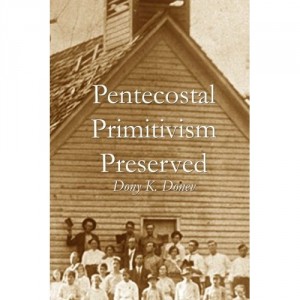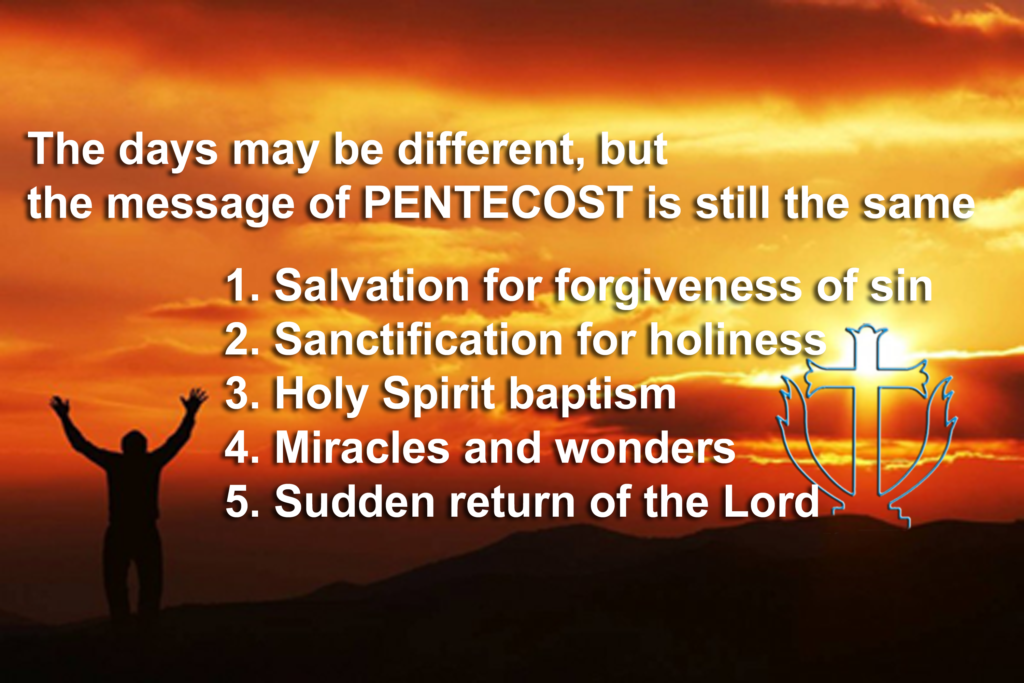Back to the Basics of Pentecost
 Since the beginning of the 21st century, only 6-10% of new born believers in America receive the Baptism with the Holy Spirit, which by 2018 has resulted in:
Since the beginning of the 21st century, only 6-10% of new born believers in America receive the Baptism with the Holy Spirit, which by 2018 has resulted in:
- Over 60% within Global Pentecostalism do not speak in tongues
- A major doctrinal shift within Pentecostal Theology today claims speaking in tongues is not the only evidence of Holy Spirit Baptism
- Some theologians even claim there is no initial evidence in the Bible
- Others today go further to believe that no outward sign of the Holy Spirit baptism is necessary.
For this reason, WE are re-committing ourselves and ministry to revival and restoration of the Pentecostal Message through praying, fasting and preaching:
- Salvation of the sinner’s soul and entire sanctification through the Blood of Jesus
- Baptism with the Holy Spirit and fire with initial evidence of speaking in tongues
- Supernatural gifts and ministries of the Holy Spirit
- Healing, deliverance and signs following
- Pre-Millennial return of Christ and pre-Tribulation Rapture of His Church to glory
Please consider the URGENCY of this generation!
Let us reason together what can we do to prevent this rapid decline in Biblical spirituality.
Revival will not come without preaching!
Revival of Pentecost will not come without preaching the Message of Pentecost.
The message of PENTECOST is still the same…
February 10, 2023 by Cup&Cross
Filed under 365, Featured, News, Publication
Since the beginning of the 21st century, only 6-10% of new born believers in America receive the Baptism with the Holy Spirit, which by 2018 has resulted in:
- Over 60% within Global Pentecostalism do not speak in tongues
- A major doctrinal shift within Pentecostal Theology today claims speaking in tongues is not the only evidence of Holy Spirit Baptism
- Some theologians even claim there is no initial evidence in the Bible
- Others today go further to believe that no outward sign of the Holy Spirit baptism is necessary.
For this reason, WE are re-committing ourselves and ministry to revival and restoration of the Pentecostal Message through praying, fasting and preaching:
- Salvation of the sinner’s soul and entire sanctification through the Blood of Jesus
- Baptism with the Holy Spirit and fire with initial evidence of speaking in tongues
- Supernatural gifts and ministries of the Holy Spirit
- Healing, deliverance and signs following
- Pre-Millennial return of Christ and pre-Tribulation Rapture of His Church to glory
Please consider the URGENCY of this generation!
Let us reason together what can we do to prevent this rapid decline in Biblical spirituality.
Revival will not come without preaching!
Revival of Pentecost will not come without preaching the Message of Pentecost.
Speaking in Tongues in America Prior to the Azusa Street Revival of 1906
April, 1906 – The Azusa street revival swept the globe starting with California
January 1, 1901– The initial phenomenon of speaking in tongues occurred at Parham’s school in Topeka, Kansas
January 6, 1900 – Frank Sanford’s Shiloh school reported that “The gift of tongues has descended”
1896 – Over 100 people baptized in the Shaerer schoolhouse revival conducted by the Christian Union in the North Carolina mountains
1887 – People falling in trances and speaking in tongues were reported at Maria Etter’s revival meetings in Indiana
1874 – Speaking in tongues occurred during healing meetings reported in New York
1873 – William H. Doughty and the Gift People of Rhode Island spoke in tongues
1854 – V. P. Simmons and Robert Boyd reported tongue speaking during Moody’s meetings

FURTHER READING:
Church of God (Cleveland, TN)
- Alive, alive! (A personal testimony)
- Church of God Primitivism
- Bulgarian Church of God
- J.W. Buckalew
- Why revival came? by Dr. Charles Conn
Azusa Street Revival of 1906
- Lucy F. Farrow: The Forgotten Apostle of Azusa
- The FORGOTTEN ROOTS OF THE AZUSA STREET REVIVAL
- Azusa Street’s Apostolic Faith Renewed
- Azusa Street Sermons
- Pentecostal Primitivism Preserved
Prior to Azusa Street Revival of 1906
- First person to speak in tongues in the Assemblies of God was William Jethro Walthall of the Holiness Baptist Churches of Southwestern Arkansas
- The Work of the Spirit in Rhode Island (1874-75)
- Speaking in Tongues in America Prior to the Azusa Street Revival
- WAR ON THE SAINTS: Revival Dawn and the Baptism of the Spirit
- How Jezebel Killed One of the Greatest Revivals Ever
As Pentecostals historically…
As Pentecostals historically (and as a movement)
We have been looking for power when we should have been seeking after His presence
We have been looking for gifts and signs and wonders, when we should have been looking for fruits of the Spirit and of character
We have been looking for preachers and prophets to follow, when we should have been looking for God’s presence to abide in
We have been looking for prophetic words and utterance, when we should have been taking more time in personal prayer
We have been growing, when we should have been going
And going when we should have been learning in the Spirit
We have been looking for more ways to build, when we should have been looking for more ways to move and go
We have been looking for ways to influence the world, instead of looking to be uninfluenced by God
And in our desire to be leaders and influencers, we have forgotten how to be led by God
And for a long time as a movement, we have existed at the borderline, at the verge and at the danger of gaining our rightful place in human history, but loosing our royal position in the GLORY of GOD
BUT ONE THING WE DID GET RIGHT: The Baptism with the Holy Ghost (watch the full message)
Read also: Last Days Great REVIVAL
20 recent Pentecostal articles in light of the upcoming Pentecostal Sunday celebration:
- The Forgotten Azusa Street Mission: The Place where the First Pentecostals Met
- Diamonds in the Rough-N-Ready Pentecostal Series (Complete)
- 95th anniversary of the Pentecostal movement in Bulgaria
- Toward a Pentecostal Solution to the Refugee Crises in the European Union
- Historical and Doctrinal Formation of Holiness Teachings and Praxis among Bulgarian Pentecostals
- Pacifism as a Social Stand for Holiness among Early Bulgarian Pentecostals
- The Practice of Corporate Holiness within the Communion Service of Bulgarian Pentecostals
- Sanctification and Personal Holiness among Early Bulgarian Pentecostals
- First Pentecostal Missionaries to Bulgaria (1920)
- Historical and Doctrinal Formation of Holiness Teachings and Praxis among Bulgarian Pentecostals
- The Everlasting Gospel: The Significance of Eschatology in the Development of Pentecostal Thought
- Online Pentecostal Academic Journals
- What made us Pentecostal?
- Pentecostalism and Post-Modern Social Transformation
- Obama, Marxism and Pentecostal Identity
- Why I Decided to Publish Pentecostal Primitivism?
- Historic Pentecostal Revival Tour in Bulgaria Continues
- The Land of Pentecostals
- Pentecostal Theological Seminary Address
- A Truly Pentecostal Water Baptism
How to Detect a Pedophile: Characteristics, Mannerisms and Personality in 2023
By Kathryn N. Donev, LPC/MSHP, NBCC.
Pedophilia is a medically diagnosable disorder typically “defined as a psychiatric disorder in adults or late adolescents (persons age 16 and older) characterized by a primary or exclusive sexual interest in prepubescent children (generally age 13 years or younger, though onset of puberty may vary)”(Wikipedia). It is a disorder that does not discriminate by race, class or age. The Department of Justice estimates, approximately 400,000 convicted pedophiles currently reside in the United States (Snyder). The following will attempt to present a profile of a pedophile in order to make aware their tactics and typical personality traits used as part of a strategy to take advantage of innocent children.
SOCIALLY CHALLENGED
According to the American Psychiatric Association the overwhelming majority of pedophiles are male. They are typically more religious than not and over the age of 30 (Montaldo, Ruggles). Researcher reports a correlation between pedophilia and certain psychological characteristics, such as poor social skills (Emmers-Sommer). Pedophiles are typically antisocial with few friends and not in a relationship. If in a relationship, they will more likely be in a superficial one with a person whom has a child of their preferred age range whom they can target. If married, the relationship is more “companion” based with no sexual relations and is typically dysfunctional providing only a façade to their real identity (Montaldo).
INTROVERTED CHARACTER
Being an introvert, they will prefer to keep personal information limited. They are often vague about past history. If closed off to real intimate relationships then they do not have to share their real identity from which they are hiding. This achieved goal of avoidance is considered a great personal accomplishment and is one of the ways they compensate for low self-esteem. However, they will present such an overwhelming caring personality that purposes to form “intimate” bonds in which they will invest in listening to the lives of those around them. This bond will appear so real that one overlooks that there is no reciprocity of sharing and in reality you know nothing to very little about the pedophile with whom you feel close.
DEMONSTRATIVE PERSONALITY
Pedophiles may also demonstrate increased personal affection. You may observe that this type of person is “a hugger” or will constantly enter ones personal space and do so at times without invitation. This characteristic is accepted as a personality trait and innocently overlooked and excused. After time, one begins to subconsciously let their guard down as systematically the pedophile becomes closer to you and your loved ones entering an intimate realm. They also may attempt to exaggerate situations to test the limits of an individuals understanding. For example if another protests the initial reaction or exaggeration presented by the pedophile then this information give an insight to ones awareness level and how easily they may be manipulated.
PROFESSIONAL MANIPULATORS
Even though some studies show that a pedophile has lower intellectual abilities and self-esteem (Marshall) they are skillful professional manipulators. They are so successful they are able to present a non-unlikeable persona. Meaning they are overly friendly and engaging to the point where one finds themselves in a relationship without even making a conscious effort. Their personality is so magnetic that it attracts children and adults alike. One allows themselves to continue with such relationship due to the appearances of trustworthiness and respectability presented by the pedophile. They are people who are in good standing in the community and will find themselves in a position of helping such as coaching, ministry leaders, volunteers, and so forth (Ruggles, Wooden).
PROTECTOR ROLE
Child molesters often make efforts to gain access to or authority over children (Wooden). Because the internal desire of a pedophile is for a child to become a possession, a child is the focus of great destructive obsession. A child is the focal point of the world of a pedophile and may often be referenced in terms which are drastically uplifting or angelic such as innocent, heavenly or divine (Montaldo). This strong child advocacy is often viewed as an innocent protective act and is one of the reasons why they are allowed to get close to children. You may also overlook all of the physical affection or photographs taken of a child because this is done in a manner which is portrayed as a service to children across the board. If a pedophile does take pictures in the open, others will be convinced that such are not for personal use but for the greater good perhaps being published in a child advocacy resource or so forth.
CHILDLIKE GESTICULATION
A pedophile, even though they charm their way into the lives of adults by trade, they prefer to be around children more so feeling more comfortable and understood. They surround themselves with items that will make them more appealing to children perhaps even including the way they dress. Some even control the way they talk and prefer to use a soft, slow, gentle, childlike, and more so feminine voice over a strong, threatening, controlling manly voice. They obsessively prefer childlike activities over adult ones. They may test the acceptance level of playing children’s’ games with children by first attempting to see if adults like to play such games as well.
UNDERDOG MENTALITY
It is true that some pedophiles are highly intellectual. Yet they will use any intellectual difficulty or perceived difficulty to their advantage and enjoy being the “underdog”. This allows them to reach out to even the most unaware unknowledgeable person for help with everyday tasks. It is a part of human nature to help those in need and a pedophile will use this to their advantage. This is how they get their foot in the door in order to silently but skillfully creep into your community, social network and ultimately your personal home. You may see this characteristic demonstrated in the constant reminder that they are from a different town and are not familiar with the local culture or area. Or they may obsessively seek your guidance, assistance or approval for even the smallest of tasks. They play off of ones need to be needed.
EPILOGUE
Remember pedophiles are professional manipulators and you will have to make a conscious effort to see through the sophisticated front which they have learned to master. Keep in mind that you should always trust your internal instincts. This is one area in which a pedophile has no advantage over you. Do not attempt to convince yourself that what you are sensing is not real for it is when you fall into this trap that you begin to slowly lose touch with reality and are bewildered and sucked into a lie one which is too dangerous to ignore. Never be afraid by the lies that I will hurt ones feelings if I make aware my observations or I am being too pushy by trying to get more history on a person who is so closed off. When all of the signs are present it is our responsibility as true child advocates to protect our children at any cost.
2011. Copyright. All Rights Reserved by Author and CCMI Consortium. Not to be reproduced in any manner without permission of author or CCMI.
Works Cited
American Psychiatric Association. Fact sheet: pedophilia. Available at:www.medem.com/index.cfm. Accessed March 01, 2011.
Emmers-Sommer, T. M., Allen, M., Bourhis, J., Sahlstein, E., Laskowski, K., Falato, W. L., et al. A meta-analysis of the relationship between social skills and sexual offenders. 2004. Communication Reports, 1–17.
Marshall, W. L. The relationship between self-esteem and deviant sexual arousal in nonfamilial child molesters. 1997. Queens University. Sage Journal Publication of Behavior Modification.
Montaldo, Charles. Profile of a pedophile. Available at: www.about.com. Accessed March 17, 2011.
Ruggles, Tammy L. Profile of a pedophile. Available at www.mentalhealthmatterss.com. February 2009. Last Updated on Tuesday, 28 September 2010 15:46. Accessed March 5, 2011.
Snyder, Howard N. Sexual Assault of Young Children as Reported to Law Enforcement: Victim, Incident, and Offender Characteristics. Washington, DC: US Department of Justice, Bureau of Justice Statistics; 2000. Publication NCJ 182990.
Wikipedia. Article: pedophilia. Available at www.wikipedia.org. Accessed March 15, 2011.
Wooden, Ken, (with Rosemary Webb & Jennifer Mitchell). Think First & Stay Safe™ Parent Guide. A profile of the child molester. 2010. Publication Child Lures Prevention/Teen Lures Prevention.
Fulfilling the Great Commission by 2033?
Dr. Billy Wilson and Dr. Rick Warren hold ‘2033 Leaders Consultation’
NEW YORK — More than two dozen ministry leaders of significant global networks convened Dec. 5-6 in New York City to combine their experience and insights toward the goal of Great Commission fulfillment within the next decade.
Hosted by Dr. Billy Wilson, Oral Roberts University President, Pentecostal World Fellowship Chair and Empowered21 Global Chair, and Dr. Rick Warren, Executive Director of Finishing the Task and Founding Pastor of Saddleback Church, the event brought the leaders representing significant denominations, para-church networks and evangelistic ministries from around the world together for prayer, connection and collaboration.
“I believe we are entering the most important decade of Great Commission effort in the history of the church,” shared Dr. Wilson. “Numerous 2033 initiatives were represented in this consultation and it was a joy to witness our shared passion and unity across the diversity of the body of Christ. The next decade is going to be amazing as we push together toward providing everyone on planet earth the opportunity to know Jesus as their savior.”
The two-day meeting ended with the development of a commitment document agreeing to significant efforts over the next decade, including collaborating with one another, praying for the salvation of others, mobilizing followers of Jesus to join in the efforts, investing increased resources for evangelism and going with the good news to the ends of the earth.
“In our polarized world, it’s easy to erect walls and go it alone with just your own tribe,” noted Warren. “It takes courage to build bridges to others who love Jesus but don’t believe or practice the faith in the same way you do. On Dec. 5, as I listened and watched a small group of 24 influential Christian leaders, representing a wide spectrum of the Body of Christ, step out of their comfort zones in order to begin collaborating to complete the Great Commission, I sensed that God was smiling from Heaven. He had found a group of people willing to be an answer to Jesus’ prayer for the unity of His church that He prayed in the Garden of Gethsemane the night before He was crucified.”
The group plans to convene again at , a three-day conference and one-day stadium event hosted by Empowered21 on June 21-24, 2023 at Amsterdam RAI & Olympic Stadium. The international event will feature influential leaders and powerful speakers to launch a decade of unprecedented evangelism to get the gospel to every person on earth by 2033. For more information, visit amsterdam2023.com.
Represented Organizations
The following organizations and ministries were represented at the Dec. 5-6 event:
- Brian Alarid, America Prays & World Prays
- Doug Beacham, International Pentecostal Holiness Church
- Keith Boyette, Global Methodist Church
- Henry Cappello, Global 2033
- Samuel Chiang, World Evangelical Alliance
- Doug Clay, Assemblies of God
- Dick Eastman, Every Home for Christ
- Oliver Fleury, Jesus Celebration 2033
- Mart Green, Hobby Lobby
- Bobby Gruenewald, YouVersion
- Tim Harlow, National Association of Christian Churches
- Alan Hawkins, Anglican Church in North America
- Rob Hoskins, OneHope
- James Hwang, Billion Soul Harvest
- Young Cho, Billion Soul Harvest
- Everton Jackson, Baptist World Alliance
- Werner Nachtigal, GO Movement
- Michael Oh, Lausanne Movement
- Nick Perryman, Alpha
- Thomas Schirrmacher, World Evangelical Alliance
- Rick Warren, Finishing the Task
- David Wells, Pentecostal Assemblies of Canada
- Michael White, Rebuilt Parish / Church of the Nativity
- Billy Wilson, ORU and Empowered21
- Caleb Wehrli, Empowered21
- Ashley Wilson, Empowered21
Participating Leader Quotes
“After our meeting, the World Evangelical Alliance is even more committed to ‘2033.’ It was a great meeting of collaboration, planning and global leaders becoming friends for the gospel’s sake.” — Thomas Schirrmacher, Secretary General, World Evangelical Alliance
“The rising global generation is perhaps the most cause-oriented generation in the history of the world. This call and clear statement from the leadership of the global Church to reach everyone in the world with the love, truth and power of Jesus is going to be incredibly appealing for a decade of unprecedented evangelism.” — Rob Hoskins, President, OneHope
“It’s inspiring and exciting to be part of a coalition across global Christianity focusing on global evangelism by the year 2033. The spirit of prayer and unity is palpable.” — Doug Beacham, Superintendent, International Pentecostal Holiness Church
“I was inspired and envisioned by the unity amongst all Christian leaders and the commitment to engage and collaborate to finish the task of the Great Commission. This is the beginning of a new era, with an incredible momentum, through which every person can be reached with the Gospel message.” — Henry Cappello, International Director, Global 2033
“Imagine that we live in a time when it is possible to reach the whole world with the Gospel. We’re excited to call the Church to join us for this incredible decade of evangelism.” — Werner Nachtigal, Founder, GO Movement
“What an amazing privilege to meet with global leaders passionate about accelerating the fulfillment of the Great Commission. We have a unique opportunity to unite across the Christian church to ensure that every person hears and has an opportunity to hear and respond to the Gospel of Jesus Christ” — Keith Boyette, Connectional Officer, Global Methodist Church
“What a historic meeting of like-minded Global leaders gathered around Jesus for the biggest push ever for the Great Commission. The Ecclesia has the best Good News ever told. And this broken world desperately needs hope at a geo-politic level and transformation at a personal level. A powerful united Global Momentum has begun.”
— Olivier Fleury, Founder and President, JC2033
“The call towards collaboration of the body of Christ to reach 8 billion is an exciting and encouraging opportunity for the Global Church. This is a crucial, historic, unprecedented work of God.” — Bishop Alan Hawkins, Chief Operating Officer, The Anglican Church in North America.
About Empowered21
Empowered21 is a global Spirit-filled movement working to connect the generations for blessing, impartation and a fresh outpouring of the Holy Spirit in the 21st century. Its U.S. office is on the campus of Oral Roberts University, of which Empowered21 Global Chair Dr. Billy Wilson is president. To learn more, visit empowered21.com.
29 Years in America
I came to the United States 29 years ago to the date – 29 of my 33 years in ministry I spent preaching here. Over a quarter of a century ago in Chicago, I helped start the first Bulgarian Church of God outside of Bulgaria. You can read about this here: https://cupandcross.com/25-years-ago-in-chicago/ and from my first dissertation here: https://cupandcross.com/a-quarter-of-a-century-ago-in-chicago/
Next year, I will be 50. Naturally, I’ve seen a few things change. I am not talking just about political correctness, cheap import quality or long distance customer service. Yes, I can say this because I am an immigrant too. But in my line of work, I made my mind a long time ago. No Made in China sermons or creative commons mini series downloaded from the internet. When I preach, I will give it my best so help me God.
Having said this, I wish I would have lived in States in the late 70s. Big cars, cheaper gas, cleaner foods, much clearer standards and maybe even a much simpler life. All made in America. And a very different type of people and churches. But we all come to this world when it’s our time…
I landed in New York late one cold and snowy night. Being barely 19 at the time, I had recently watched Home Alone: Lost in New York. Landing over the brightly lit Manhattan was just like in the movie. The feeling was indescribable.
Not so much after going through customs. The officer, a professing Muslim as he told me, took one quick look at my passport before giving me a long lecture of all the dangers I was facing by enrolling in the Bible College named on my entrée visa. I disregarded his words, at least at the time. But they haunted me often for the next couple of years.
The heavy snow storm halted all flights out of the city and we had to spend the night in the Big Apple. Waiting for the hotel’s shuttle at JKF’s lobby, I had my second peculiar encounter of the evening. A well dressed lady, obviously a New Yorker, waiting alongside picked up a conversation hearing it was my first visit to the States. She welcomed me with the words that everyone in America has come from somewhere else. She then gave me a dime, which I still keep somewhere, showing the words inscribed on the back side “E pluribus unum,” the meaning of which I knew from my studies in Latin.
The next morning I had my first American breakfast right before flying over to Charlotte. The South welcomed us with some of its coldest weather ever recorded. It was 1994 and 15F. Some even said I brought the winter with me from the old country. And so my journey began.
At first, dreams started to come to reality fast. Many dreams – too many to even count. For a short time, life was a highway. A few trials later, I sobered up. The high places of life are still reached via the narrowest of roads. And through a personal walk. Can’t get there driving fast and furiously or piggyback riding someone else’s dreams.
Because just when you have it all, there comes a time for losing. I lost friends I knew and enemies I didn’t know I had. And I learned to tell my story. Most of it is told in my book Confessions. Not merely in the way I know it, but in a way where others can understand it. And use it.
As I was getting ready to commemorate this anniversary, along with the passing of my faithful father and my praying grandmother this time 20 years ago, I lost another friend. A praying man, a faithful supporter of our ministry, a Man who walked straight and stood up for what was right – a legacy in the minds of many. I told his dear family at the grave site that a generation is passing. Their mantle has been thrown upon us, so we may become carriers of their legacy.
After 25 years, this is our time! We are here and now, so generations may come after us to a new reality, new place in history and new world. The world we’ve dreamed of…
CORONAVIRUS STATEMENT by Cup & Cross Ministries International
CORONAVIRUS STATEMENT by Cup & Cross Ministries International
The United Nations have just declared the Coronavirus (COVID-19) a global pandemic. Most European flights are suspended and a number of countries in our area of ministry remain closed. Alternatively, CDC has issued a detail set of resources for faith-based communities and their leaders for preventing COVID-19. As a result, churches are cancelling their Sunday services, conferences and international assemblies.
Having full awareness of the above and convinced by the Bible that “It is not the healthy who need a doctor, but the sick,” according to Mark 2:17
WE HEREBY AFIRM that:
- Divine healing [is] provided for all in the Atonement (Psalm 103:3; Isaiah 53:4, 5; Matthew 8:17; James 5:14-16; 1 Peter 2:24 – 42nd A., 1948, pp. 31, 32)
- “The prayer of a righteous person is powerful and effective” (James 5:16)
- And that there is still “power, power, wonder working power in the blood of the Lamb” (L.E. Jones, 1899)
For 30 years now, every public prayer we have held around the Globe has ended with these words:
“WE COMMAND every sickness, every disease, every virus
and ever infection, every tumor and every cancer
to leave the body of the believer in the name of Jesus.”
This prayer includes the Coronavirus (COVID-19) as well and therefore
WE FIRTHER AFIRM:
- Our commitment to REVIVAL especially in the year 2020
- Our long-scheduled Revival Harvest Campaign in celebration of the First Centennial of Pentecostalism in Bulgaria (1920-2020)
- Our readiness to respond to every church, state and national office that contacts us with a request to schedule our ministry in due time.
The Cross of Calvary cancels every coronavirus!
Revival must go on…
Sincerely,
Dr. Dony & Kathryn Donev
Cup & Cross Ministries International
Put-up or shut-up (for leaders)
Nothing smacks of poor leadership like a lack of performance. Nobody is perfect, but leaders who consistently fail are not leaders, no matter how much you wish they were. While past performance is not always a certain indicator of future events, a long-term track record of success should not be taken lightly. Someone who has consistently experienced success in leadership roles has a much better chance of success than someone who has not. It’s important to remember unproven leaders come with a high risk premium. Smart companies recognize potential, but they reward performance.
Not paying attention to the person
Leaders not attuned to the needs of the market will fail. As the old saying goes, if you’re not taking care of your customers, someone else will be more than happy to. Successful leaders focus on the consumer experience, which in turn leads to satisfaction and loyalty. The best leaders find ways to consistently engage the consumer and incorporate them into their innovation and planning initiatives. If you ignore, mistreat, or otherwise don’t value your customer base, your days as a leader are most certainly numbered.
The “A” word: Real leaders are accountable
Real leaders are accountable. They don’t blame others, don’t claim credit for the success of their team, but always accept responsibility for failures that occur on their watch. Most of all, leaders are accountable to their team. I’ve always said that leaders not accountable to their people will eventually be held accountable by their people.




![51DUWeyraBL._SY344_PJlook-inside-v2,TopRight,1,0_SH20_BO1,204,203,200_[1]](https://cupandcross.com/wp-content/uploads/2014/04/51DUWeyraBL._SY344_PJlook-inside-v2TopRight10_SH20_BO1204203200_1.jpg)









